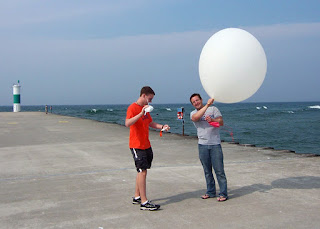January 26th, 2012 by Irene Miles
University of Illinois atmospheric scientist David Kristovich tested a mobile sounding system that might help predict the fate of storms that move across Lake Michigan. This system measures temperature, humidity, and atmospheric pressure.
“The Great Lakes make it difficult to predict summer weather. One problem weather forecasters face is determining what will happen when massive storms reach one side of the lake. It is hard to figure out if those storms will make it across to the other side and cause severe weather,” Kristovich said. “We don’t have a lot of information. On the lake, we don’t have people taking observations all over the place like we do on land.”
The device they used is called a rawinsonde, which is attached to a weather balloon with a parachute. Because the system is connected to a balloon, researchers were also able to record the wind direction and speed.
Kristovich said having a test run for the device was critical for ironing out issues for future projects.
This study is one of many funded as development of “seed” grants for researchers, either to begin start-up studies that may grow into larger work, or to complete ongoing projects. This project and others are highlighted in our latest issue of our newsletter, The Helm.
January 11th, 2012 by Irene Miles
Purdue University ecologist Patrick Zollner studied how people walking on nature trails can affect the reproduction habits of the Karner blue butterfly, which is a federally endangered species.
Resource managers are under increasing pressure to implement strategies that address the negative effects of outdoor recreational activities on wildlife. The study shows that human recreation can disrupt the breeding patterns of Karner blue butterflies, as well as other species.
Using a simulation model, the project found that significantly fewer eggs are laid by Karner blue butterfly females in sites at the Indiana Dunes National Park that are 10-15 meters from the trail. Plants that are farthest away have the most eggs. Zollner suggests that habitat patches be at least 25 meters from the trail.
“Depending on the circumstances, about 17 percent of the females are only laying half of their potential eggs because of human dis¬turbance,” Zollner said.
Zollner has studied how traffic affects Indiana wildlife and has submitted a proposal to study how the Huron-Manistee National Forest equestrian population impacts Karner blue butterflies.
This study is one of many funded as development of “seed” grants for researchers, either to begin start-up studies that may grow into larger work, or to complete ongoing projects.
This project and others are highlighted in our latest issue of our newsletter, The Helm. You can also read the complete study (PDF).
January 5th, 2012 by Irene Miles
IISG’s Asian Carp Marketing Summit in September of 2010 played a significant role in bringing jobs and invasive species solutions to Illinois, as highlighted in one of The Telegraph’s Top 10 local stories of 2011.
The summit brought together representatives from restaurants, commercial fishing, processing and related businesses, as well as agencies and academic institutions to discuss ways to address the potential threat that Asian carp pose to the Illinois River and the Great Lakes.
January 4th, 2012 by Irene Miles
 Times Square—some call it the crossroads of the world. Annually, over 450 million people pass through this historic and dazzling site.
Times Square—some call it the crossroads of the world. Annually, over 450 million people pass through this historic and dazzling site.Since late December 2011 (which included the world famous New Year’s Eve celebration that attracts many, many thousands) Sea Grant and the American Veterinary Medical Association (AVMA) are informing audiences on the issue of medicine disposal on the CBS JumboTron “Super Screen.” The 15-second spot will run through March 31 about 18 times every day or about every 80 minutes. The screen is located on 42nd Street between 7th and 8th avenues in Times Square Plaza.
The public service announcement is raising awareness on the importance of not flushing unused medicine. Audiences are informed that medicines can contaminate lakes, rivers and drinking water, posing a threat to people, animals, and the environment.
This opportunity came about as a result of the publicity related to the partnership between NOAA’s National Sea Grant College Program and the AVMA, which was officially established in November in a Memorandum of Understanding. Illlinois-Indiana Sea Grant is conducting the MOU on behalf of National Sea Grant on the issue of medications dispensed for animals as well as people.
Visit
unwantedmeds.org to learn some sensible disposal options for unused medicine or contact Laura Kammin for more information on medicine collection programs.
January 4th, 2012 by Irene Miles
IISG education team members Robin Goettel and Terri Hallesy partnered with the Field Museum’s Earth Force Program to work with students and teachers on raising awareness within the Calumet region about the proper disposal of pharmaceuticals and personal care products. Earth Force engages 7th and 8th grade Chicago Public School students in action projects that address environmental issues in their community.
 Windy City Earth Force coordinator Angie Viands invited Terri and Robin to visit classrooms on December 8 and 9 to offer students important information about the pharmaceutical and personal care product disposal issue, and to help teachers and students develop successful community projects. By talking with students about the problems that pharmaceutical and personal care products can create if not properly disposed of, they will be able to develop community-based information projects that will be showcased at a youth summit on May 18, coordinated by Earth Force.
Windy City Earth Force coordinator Angie Viands invited Terri and Robin to visit classrooms on December 8 and 9 to offer students important information about the pharmaceutical and personal care product disposal issue, and to help teachers and students develop successful community projects. By talking with students about the problems that pharmaceutical and personal care products can create if not properly disposed of, they will be able to develop community-based information projects that will be showcased at a youth summit on May 18, coordinated by Earth Force.
 Participating teachers included Mr. Neely, George Pullman Elementary; Ms. McNeal, Black Elementary School; Ms. Millner, Bennett Elementary; and Ms. Whitehead, Medgar Evers Elementary. Ms. McNeal’s students are members of an after-school science club, while the other teachers instructed formal science classes.
Participating teachers included Mr. Neely, George Pullman Elementary; Ms. McNeal, Black Elementary School; Ms. Millner, Bennett Elementary; and Ms. Whitehead, Medgar Evers Elementary. Ms. McNeal’s students are members of an after-school science club, while the other teachers instructed formal science classes.
 Terri and Robin provided an overview on the medicine disposal issue, then engaged the students in a Jeopardy game, a vocabulary word scramble game, and a marble labyrinth game called Get Rid of Stuff Sensibly. Activities were selected from IISG’s Medicine Chest, “It’s What You Can’t See” education tabloid from PA Sea Grant, and other curriculum materials.
Terri and Robin provided an overview on the medicine disposal issue, then engaged the students in a Jeopardy game, a vocabulary word scramble game, and a marble labyrinth game called Get Rid of Stuff Sensibly. Activities were selected from IISG’s Medicine Chest, “It’s What You Can’t See” education tabloid from PA Sea Grant, and other curriculum materials.
Photos:
1) Ms. Millner’s students learn about medicine disposal by reading the new Great Lakes Sea Grant education tabloid, “It’s what you can’t see…Learn about hidden chemicals in your water.”
2) Environmental science club members at Black Elementary are fascinated play the GROSS marble game and learn about properly disposing of household items.
3) Ms. Whitehead’s students research unwanted medicines and personal care products to solve a word scramble activity.
This “Undo the Chemical Brew” education project is funded through the Great Lakes Restoration Initiative. Check out the latest information on www.unwantedmeds.org.
December 20th, 2011 by Irene Miles

It isn’t always easy to do the right thing. Especially when it comes to properly disposing of unused medicine. But, in Macon County, Illinois residents can now get unused controlled substances, such as pain medications, out of their houses. IISG recently purchased a collection box for the Maroa Police Department. This program is, in fact, the only place in Macon County that can accept controlled substances. All medications collected will be incinerated; keeping the drugs off of the streets and out of the water.
December 14th, 2011 by Irene Miles
The Buffalo River was subjected to a great deal of industrial contamination years ago. Efforts at pollution prevention and cleanup have helped to rehabilitate the water way, but a great deal of contamination still exists in the sediment at the bottom of the river. These contaminants can still have a negative effect on economic, social, and environmental uses of the river, but an ongoing collaboration between a number of agencies is working right now to clean up and restore the river bottom.
The U.S. Environmental Protection Agency, U.S. Army Corps of Engineers, Buffalo Niagara RIVERKEEPER, Honeywell and several other affiliated public and private entities have teamed up to complete a two-year dredging project that will remove 1.2 million cubic yards of contaminated sediment, which will provide a clean and supportive environment for local, native species to flourish.
Part of the work is being performed under the Great Lakes Legacy Act, which revitalizes once-thriving waterways through sediment cleanups and restoration. The act requires at least 35 percent of the project cost to come from non-federal partners. IISG’s Environmental Social Scientist Caitie McCoy has provided expertise for the project. For example, she prepared the publication The Buffalo River Restoration Project: Frequently Asked Questions. The FAQ gives detailed information on the Buffalo River Restoration Project, including the project’s timeframe, funding, impact, and more.
December 13th, 2011 by Irene Miles
What do you get when you combine an aquarium, a greenhouse, and a fish farm? The answer is aquaponics.
Aquaponics is the process of operating fish farming and hydroponic plant farming in a contained system where the water is circulated, filtered, and reused between both. Here’s how it works. The water in the fish tanks builds up waste that need to be filtered out to keep the fish healthy. But this waste can actually provides nutrients for plant growth so in an aquaponic setup, that water is used to hydroponically grown plants. The plant roots filter the water by taking up and using these valuable nutrients. By circulating the water through the system in this way, both the plants and the fish benefit, and the water is reused. The system also provides a natural environment where vegetables, herbs, and fish are all raised organically.
For a great explanation of the process, as well as a tour of what an aquaponic system can look like, watch this video.
If you would like to learn more about aquaponics, contact IISG Aquaculture Marketing Specialist Kwamena Quagrainie.
December 9th, 2011 by Irene Miles
As the year ends, top ten lists begin to crop up, putting the year’s events in perspective and celebrating accomplishments. IISG has put together our own list of successes from projects that have come to fruition in recent years, and here is an example:
IISG presented a seminar on climate change, land use, and human health impacts to the Northern Indiana Regional Planning Commission (NIRPC) Environmental Management Planning Committee. The seminar led to the development of a climate change steering committee, which drafted a resolution on climate change for the NIRPC Board of Trustees. Sea Grant also participated in this process.
The NIRPC Board of Trustees approved the resolution requiring that any future planning and funding efforts that NIRPC puts forth incorporate climate change components, especially green infrastructure. This kind of action provides positive action on climate change issues, both in the near term and in the future planning. It also fosters an impact at the local level, where communities and residents will benefit directly from the improvements.







